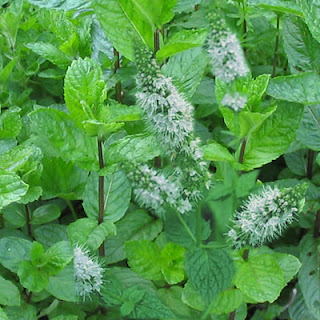 |
| Peppermint plant with flower |
Peppermint, which originates in Europe ,
is now accepted worldwide. It is widely cultivated for its oil, which is used
in flavorings and to scent perfumes and toiletries. But this herb also
has numerous curative elements for several illnesses when used appropriately.
Here's how the nature’s alternative remedy works:
Peppermint is Antispasmodic
(Relieving or preventing spasms, especially of smooth muscle), digestive tonic,
anti-emetic (drug taken to prevent or treat nausea and vomiting), carminative
(A drug that induces the expulsion of gas from the stomach), peripheral
vasodilator (an agent that causes blood vessel dilation), diaphoretic (an agent
that promotes sweating), cholagogue (a drug or other substance that promotes
the flow of bile from the gall bladder into the duodenum.), analgesic (A drug
that relieves pain), antiseptic.
Peppermint is found to contain a
great number of minerals and vitamins such as magnesium, calcium, folate,
potassium, copper, vitamin A and vitamin C that are essential for maintaining
perfect health. As the benefits of peppermint are established scientifically,
it is available even as a prescription drug. Following is a list of health
benefits of peppermint.
• Peppermint helps to improve
digestion and helps to overcome the problem of excessive stomach gas. Peppermint
leaves have been shown to help alleviate the symptoms of irritable bowel
syndrome. Fresh peppermint and peppermint leaves have long been used to treat
stomach conditions like IBS. Having a drop of peppermint oil dissolved in a
glass of water helps to get rid of the gas. It is also found to increase
appetite.
• Peppermint has also been shown
to retard the growth of many varieties of bacteria and fungi. It's thought to
help relieve symptoms of allergies and asthma as well. The antiseptic
properties of peppermint are used to get rid of toothaches that are caused due
to accumulation of germs. Hence, it is found in a great number of commercial
toothpastes. It is even used as a medicine to treat toothaches.
• Peppermint is the major
component found in menthol. This is the reason why menthol is used in clearing
respiratory problems. It is also used in cold rubs. Application of these cold
rubs help to relieve congestion in airways and helps to give relief from cold,
cough, sinusitis and asthma.
• Peppermint oil helps to relieve
symptoms such as nausea and headache. Application of diluted peppermint
oil over the forehead gives relieves from headache.
• The refreshing feel of
peppermint oil helps to overcome stress and depression. Hence, it is used to
overcome certain anxiety disorders.
• Peppermint is also used in
treating urinary tract infections.
• Peppermint also possess
analgesic properties hence supportive in reduce pain.
• Cooling effect of peppermint is
used to treat high fevers.
• Peppermint also serves to
energize the immune system and helps to prevent a great number of diseases.
• It is also found to improve
blood circulation and thus, helps to provide sufficient nutrition to all cells
of the body.
• The cooling effect of peppermint
helps to reduce dandruff and the problem of lice.
OTHER USES
TEA Add
2–3 fresh leaves to 1 cup of boiling
water and infuse for 5 minutes for everyday drinking; especially suitable after
meals.
STEAM INHALATION Add a few fresh sprigs to a basin of boiling water and use as an
inhalant to ease nasal congestion.
INFUSION Use スoz
(15g) to 2 cups of boiling water and take 1⁄2–1 cup 2–3 times daily for nausea,
indigestion, flatulence, or colic, or with other herbs for colds or catarrh.
LOTION Add
30 drops of essential oil to 1⁄2 cup vegetable oil and massage into aching muscles and joints,
or use for scabies or ringworm. Use in a spray bottle as a mosquito repellent
or foot deodorant.
You can find me on Google+
You can find me on Google+




Emoticon